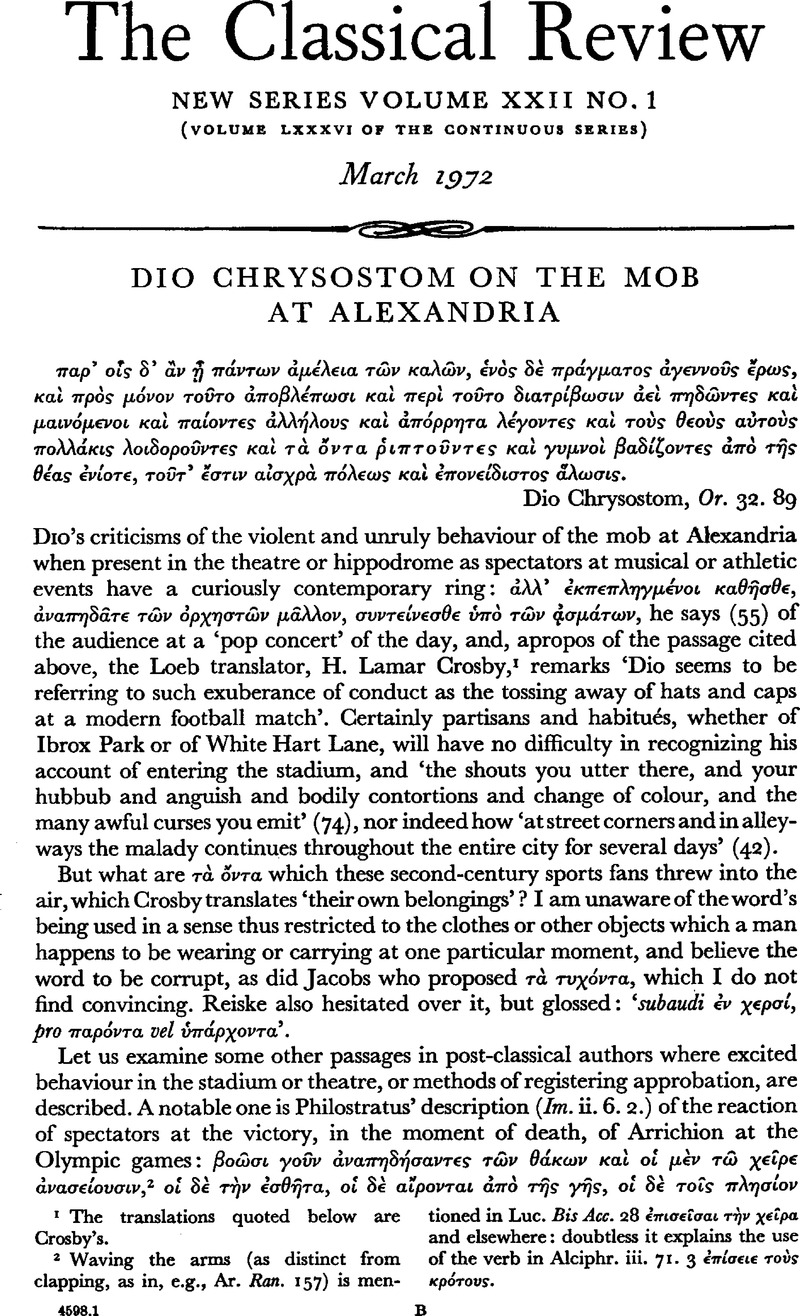Article contents
Dio Chrysostom on the Mob at Alexandria
Published online by Cambridge University Press: 27 February 2009
Abstract

- Type
- Review Article
- Information
- Copyright
- Copyright © The Classical Association 1972
References
page 1 note 1 The translations quoted below are Crosby's.
page 1 note 2 Waving the arms (as distinct from clapping, as in, e.g., Ar. Ran. 157) is mentioned in Luc. Bis Acc. 28 ⋯πισεῖσαι τ⋯ν χεῖρα and elsewhere: doubtless it explains the use of the verb in Alciphr. iii. 71. 3 ⋯π⋯σειε τοὺς κρ⋯τους.
page 2 note 1 ‘Manifestly the sort of conduct on the part of spectators that may be paralleled at football matches when the crowd unconsciously pushes in the effort to advance the ball’ (Crosby).
page 2 note 2 Cf. id. V.A. iv. 21 λῄδια ⋯νασε⋯ειν λ⋯γεσθε ἔπιπλα μετεώρως αὐτ⋯ κολπο⋯ντες.
page 2 note 3 Bast proposed ⋯νερρ⋯πτουν, but from the evidence which I shall go on to consider the ⋯πο- compound of the manuscripts may be literally correct.
page 2 note 4 One recalls also Paul's experience of the crowd at Jerusalem (Acts 22: 23)—κραυγα-ζ⋯ντων … κα⋯ ῥιπτο⋯ντων τ⋯ ἱμ⋯τια κα⋯ κονιορτ⋯ν βαλλ⋯ντων εἰς τ⋯ν ⋯⋯ρα. The throwing of dust here has apparently not been noticed elsewhere, but it is of some interest, in view of the theme of this article, that Jackson and Lake, The Beginnings of Christianity, 1. iv. 282 remark that in America it is ‘a recognized sign of a baseball-player's disapprobation of the umpire’.
page 2 note 5 Cf. Isid. Pel. epp. i. 136 (M. 78. 272 c) ⋯ ⋯θ⋯νη μεθ' ἧς λειτουργο⋯σιν ⋯ν τοῖς ⋯γ⋯οις οἱ δι⋯κονοι.
page 2 note 6 In sixth-century Byzantium spectators used for the same purpose tunics with long, billowing sleeves (cf. Vopiscus' tunicae manicatae), according to Procop. An. vii. 12 το⋯ δ⋯ χιτ⋯νος τ⋯ ⋯μφ⋯ τὼ χεῖρε μ⋯ρος τ⋯ μ⋯ν ⋯ς τ⋯ν καρπ⋯ν ξυνῄει σφ⋯σιν ⋯ν στενῷ μ⋯λιστα, τ⋯ δ⋯ ⋯νθ⋯νδε ἄχρι ⋯ς ὦμον ⋯κ⋯τερον ⋯ς. (I am indebted to Dr. R. C. McCail for pointing out this passage to me.)
page 3 note 1 Cf. Clem. Alex. Paed. ii. 10 (i. 226. 4) τ⋯ς ⋯θ⋯νας τ⋯ς ⋯π' Αἰγ⋯πτου, Eus. P.E. v. 9. 2 Νειλα⋯ην ⋯θ⋯νην. Plut. Mor. 976 b ⋯θ⋯νιον of a towel.
page 3 note 2 γυμνο⋯ of course need not be literally interpreted: cf. Dover on Ar. Nub. 498.
page 3 note 3 Cf. Ps.-Callisth. Alex. p. 3. 7 Kroll ⋯θ⋯νην ⋯μφιασ⋯μενος οἷα προφ⋯της Αἰγ⋯πτιος.
page 3 note 4 In Greek writers ⋯θ⋯νη is nearly always used of the clothing of women or orientals. The word itself is generally thought to be of Semitic origin. For its use for various types of linen material, see Moulton and Milligan, Vocabulary of the Greek Testament, s.v.
page 3 note 5 Cf. also Phot., the Suda s.v. περιαγειρ⋯μενοι.
page 3 note 6 The notice in the Suda s.v. Δρ⋯κων (which reports also that he was buried ⋯ν αὐτῷθε⋯τρῳ) adds κα⋯ ἱμ⋯τια. The Teubner editor Flach is suspicious of this, commenting ipsas enim vestes Graecos deiecisse vix credi potest.
- 2
- Cited by




